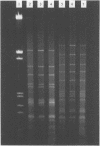Abstract
Transfer of shigella R-plasmids in vivo has seldom been demonstrated. Strains of Shigella dysenteriae type 1 and Shigella flexneri type 5b were isolated from a Bulgarian traveller who visited Vietnam and developed dysentery, which was treated with trimethoprim/sulfamethoxazole (TMP/SMZ) for a short time. Both species of shigellae are unusual in Bulgaria where strains of S. sonnei predominate. Both shigella strains were multiresistant to the same antimicrobial agents. Each strain contained a 48-kilobase plasmid that conferred the entire resistance phenotype to a susceptible Escherichia coli. Restriction endonuclease patterns of plasmid DNA from the respective strains were identical. Transmissible plasmids of the same resistance phenotypes and restriction patterns were isolated from the patient's colonic E. coli. Transconjugants hybridized to a dihydrofolate reductase type I-DNA probe. These studies support the hypothesis that R-plasmid transfer may occur between non-pathogenic, faecal strains and pathogenic shigellae, a process that may have been facilitated by inadequate treatment with TMP/SMZ at the onset of the illness.
Full text
PDF
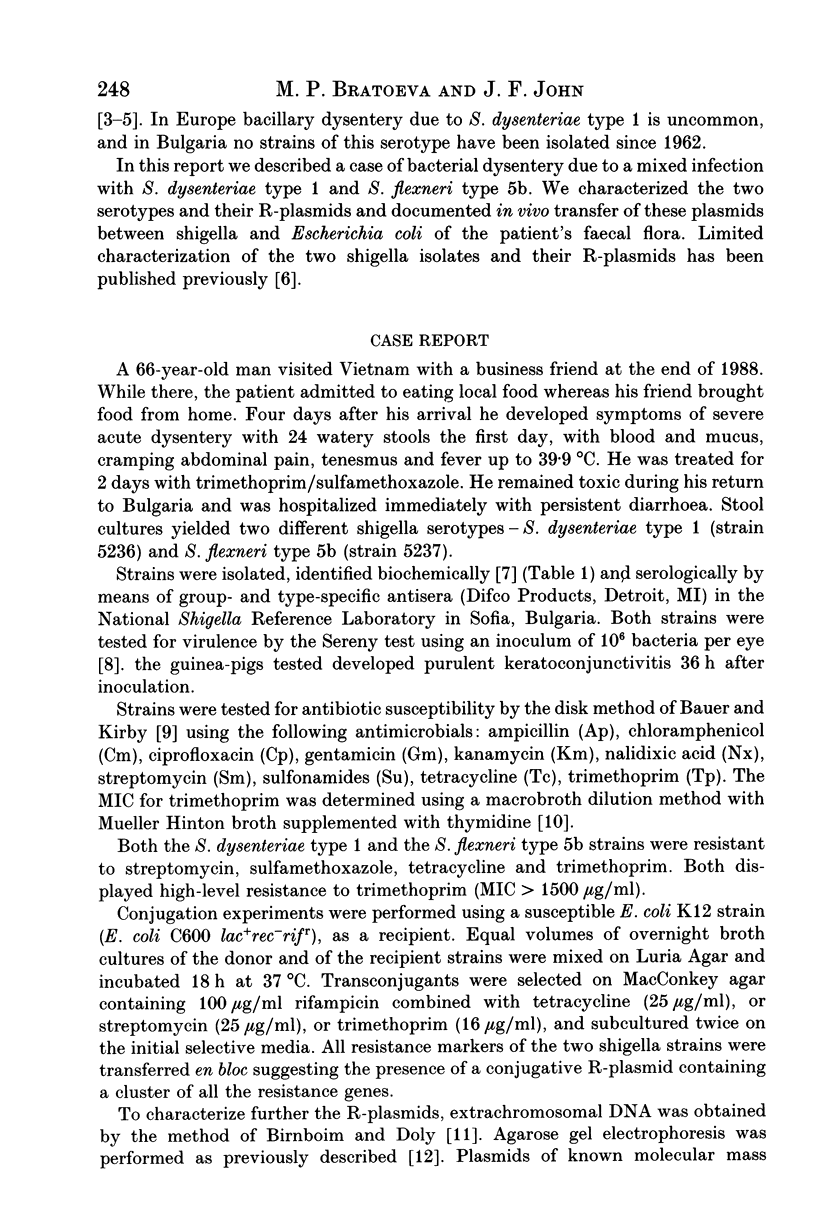
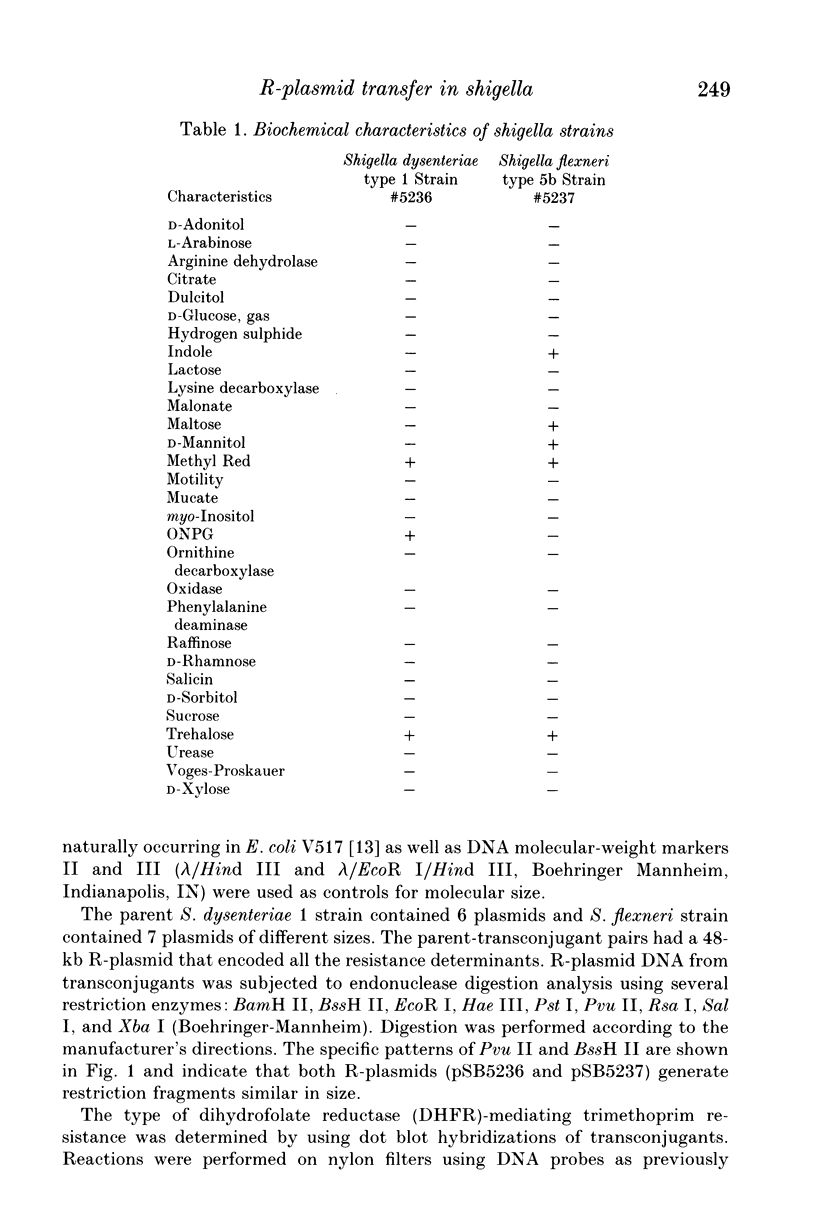
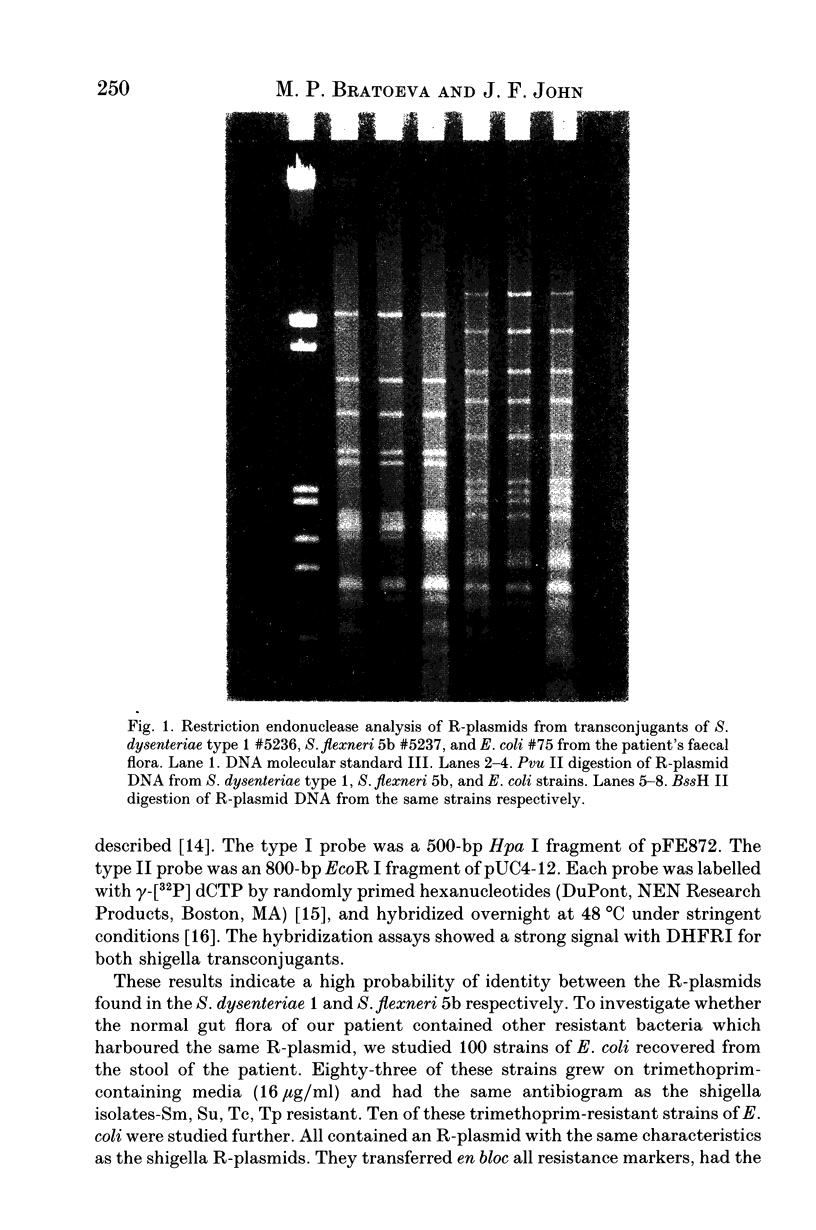
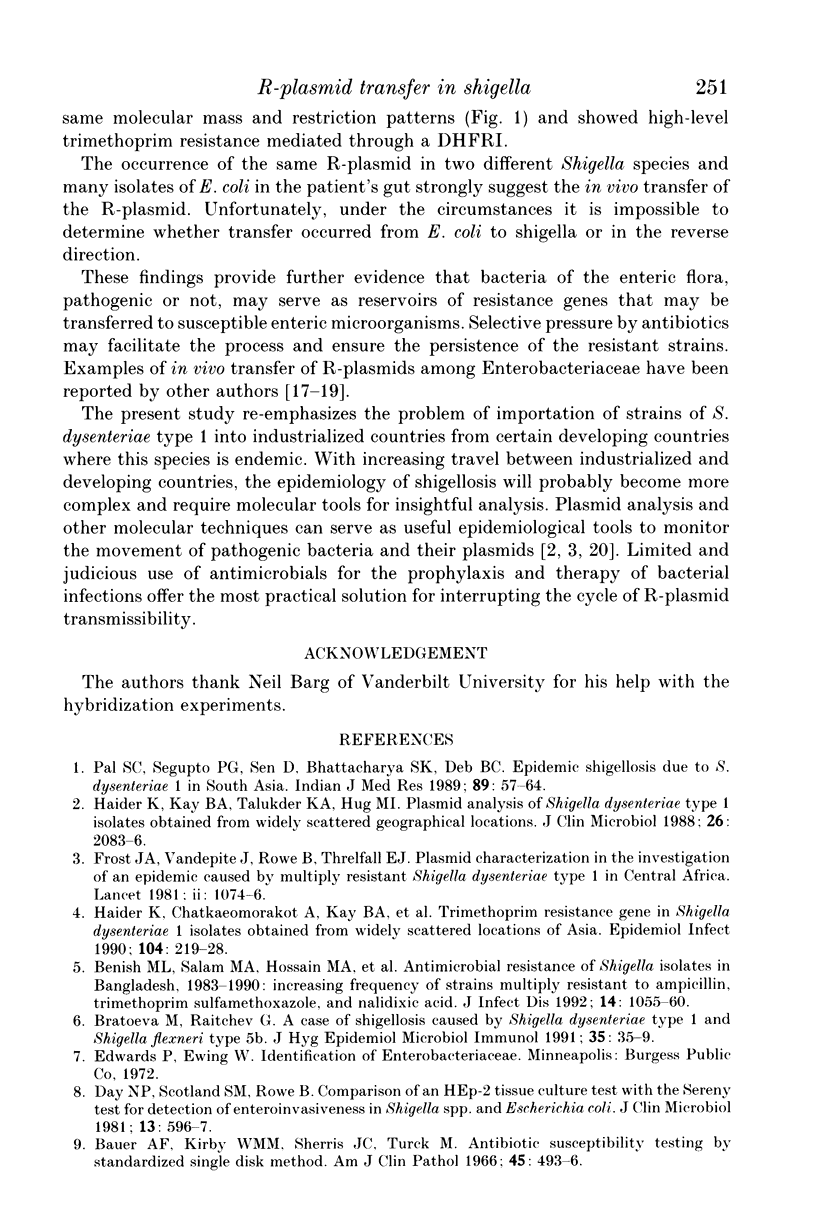
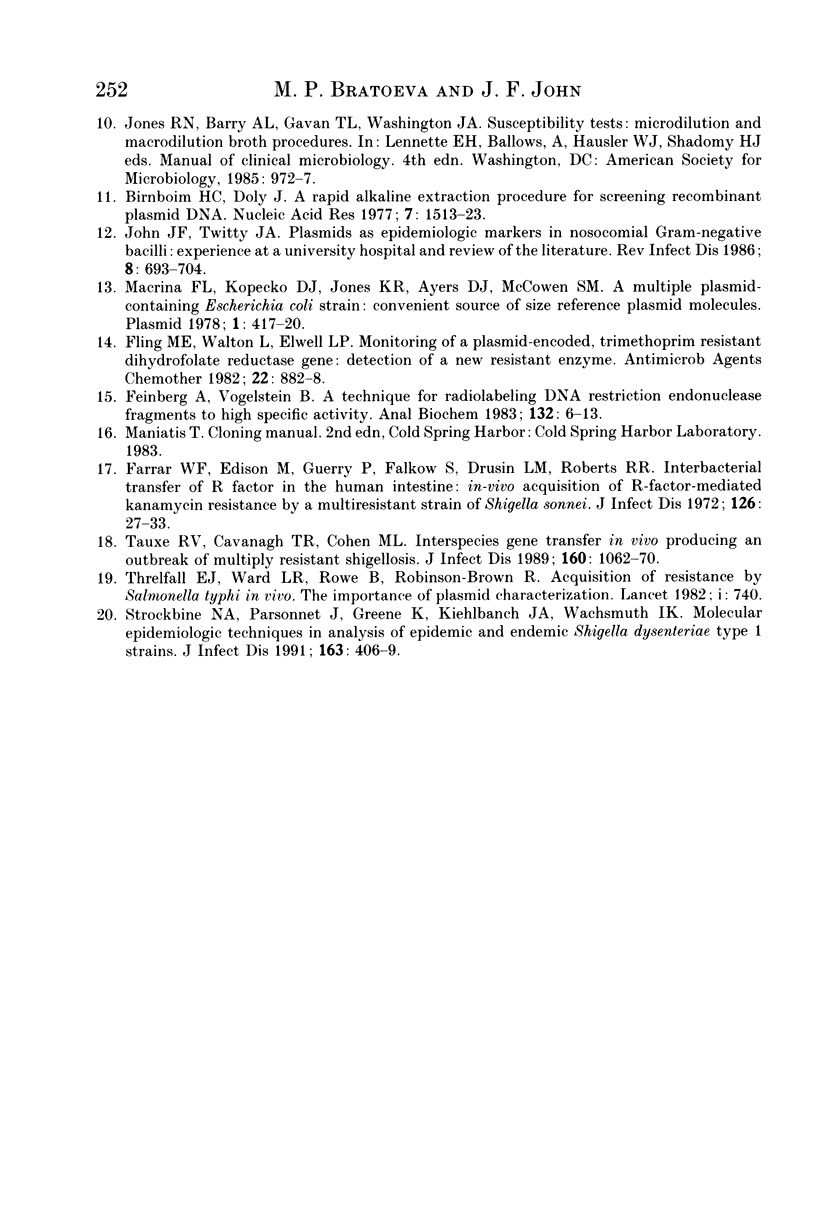
Images in this article
Selected References
These references are in PubMed. This may not be the complete list of references from this article.
- Bauer A. W., Kirby W. M., Sherris J. C., Turck M. Antibiotic susceptibility testing by a standardized single disk method. Am J Clin Pathol. 1966 Apr;45(4):493–496. [PubMed] [Google Scholar]
- Bennish M. L., Salam M. A., Hossain M. A., Myaux J., Khan E. H., Chakraborty J., Henry F., Ronsmans C. Antimicrobial resistance of Shigella isolates in Bangladesh, 1983-1990: increasing frequency of strains multiply resistant to ampicillin, trimethoprim-sulfamethoxazole, and nalidixic acid. Clin Infect Dis. 1992 May;14(5):1055–1060. doi: 10.1093/clinids/14.5.1055. [DOI] [PubMed] [Google Scholar]
- Birnboim H. C., Doly J. A rapid alkaline extraction procedure for screening recombinant plasmid DNA. Nucleic Acids Res. 1979 Nov 24;7(6):1513–1523. doi: 10.1093/nar/7.6.1513. [DOI] [PMC free article] [PubMed] [Google Scholar]
- Bratoeva M., Raitchev G. A case of shigellosis caused by Shigella dysenteriae type 1 and Shigella flexneri type 5B. J Hyg Epidemiol Microbiol Immunol. 1991;35(1):35–39. [PubMed] [Google Scholar]
- Day N. P., Scotland S. M., Rowe B. Comparison of an HEp-2 tissue culture test with the Serény test for detection of enteroinvasiveness in Shigella spp. and Escherichia coli. J Clin Microbiol. 1981 Mar;13(3):596–597. doi: 10.1128/jcm.13.3.596-597.1981. [DOI] [PMC free article] [PubMed] [Google Scholar]
- Farrar W. E., Jr, Eidson M., Guerry P., Falkow S., Drusin L. M., Roberts R. B. Interbacterial transfer of R factor in the human intestine: in-vivo acquisition of R-factor-mediated kanamycin resistance by a multiresistant strain of Shigella sonnei. J Infect Dis. 1972 Jul;126(1):27–33. doi: 10.1093/infdis/126.1.27. [DOI] [PubMed] [Google Scholar]
- Feinberg A. P., Vogelstein B. A technique for radiolabeling DNA restriction endonuclease fragments to high specific activity. Anal Biochem. 1983 Jul 1;132(1):6–13. doi: 10.1016/0003-2697(83)90418-9. [DOI] [PubMed] [Google Scholar]
- Fling M. E., Walton L., Elwell L. P. Monitoring of plasmid-encoded, trimethoprim-resistant dihydrofolate reductase genes: detection of a new resistant enzyme. Antimicrob Agents Chemother. 1982 Nov;22(5):882–888. doi: 10.1128/aac.22.5.882. [DOI] [PMC free article] [PubMed] [Google Scholar]
- Frost J. A., Rowe B., Vandepitte J., Threlfall E. J. Plasmid characterisation in the investigation of an epidemic caused by multiply resistant Shigella dysenteriae type 1 in Central Africa. Lancet. 1981 Nov 14;2(8255):1074–1076. doi: 10.1016/s0140-6736(81)91277-0. [DOI] [PubMed] [Google Scholar]
- Haider K., Chatkaeomorakot A., Kay B. A., Talukder K. A., Taylor D. N., Echeverria P., Sack D. A. Trimethoprim resistance gene in Shigella dysenteriae 1 isolates obtained from widely scattered locations of Asia. Epidemiol Infect. 1990 Apr;104(2):219–228. doi: 10.1017/s0950268800059380. [DOI] [PMC free article] [PubMed] [Google Scholar]
- Haider K., Kay B. A., Talukder K. A., Huq M. I. Plasmid analysis of Shigella dysenteriae type 1 isolates obtained from widely scattered geographical locations. J Clin Microbiol. 1988 Oct;26(10):2083–2086. doi: 10.1128/jcm.26.10.2083-2086.1988. [DOI] [PMC free article] [PubMed] [Google Scholar]
- John J. F., Jr, Twitty J. A. Plasmids as epidemiologic markers in nosocomial gram-negative bacilli: experience at a university and review of the literature. Rev Infect Dis. 1986 Sep-Oct;8(5):693–704. doi: 10.1093/clinids/8.5.693. [DOI] [PubMed] [Google Scholar]
- Macrina F. L., Kopecko D. J., Jones K. R., Ayers D. J., McCowen S. M. A multiple plasmid-containing Escherichia coli strain: convenient source of size reference plasmid molecules. Plasmid. 1978 Jun;1(3):417–420. doi: 10.1016/0147-619x(78)90056-2. [DOI] [PubMed] [Google Scholar]
- Pal S. C., Sengupta P. G., Sen D., Bhattacharya S. K., Deb B. C. Epidemic shigellosis due to Shigella dysenteriae type 1 in south Asia. Indian J Med Res. 1989 Mar;89:57–64. [PubMed] [Google Scholar]
- Strockbine N. A., Parsonnet J., Greene K., Kiehlbauch J. A., Wachsmuth I. K. Molecular epidemiologic techniques in analysis of epidemic and endemic Shigella dysenteriae type 1 strains. J Infect Dis. 1991 Feb;163(2):406–409. doi: 10.1093/infdis/163.2.406. [DOI] [PubMed] [Google Scholar]
- Threlfall E. J., Ward L. R., Rowe B., Robins-Browne R. Acquisition of resistance by Salmonella typhi in vivo: the importance of plasmid characterisation. Lancet. 1982 Mar 27;1(8274):740–740. doi: 10.1016/s0140-6736(82)92649-6. [DOI] [PubMed] [Google Scholar]



